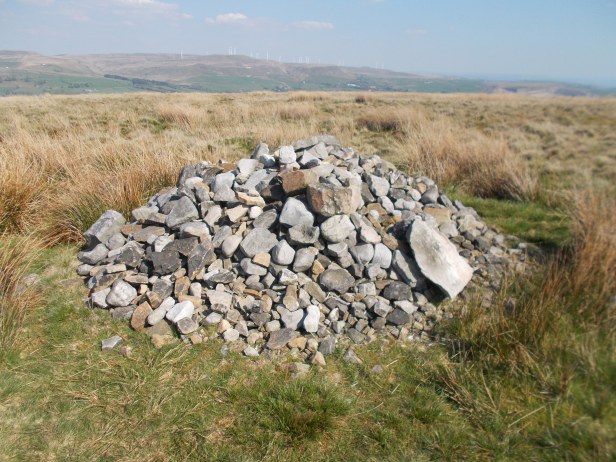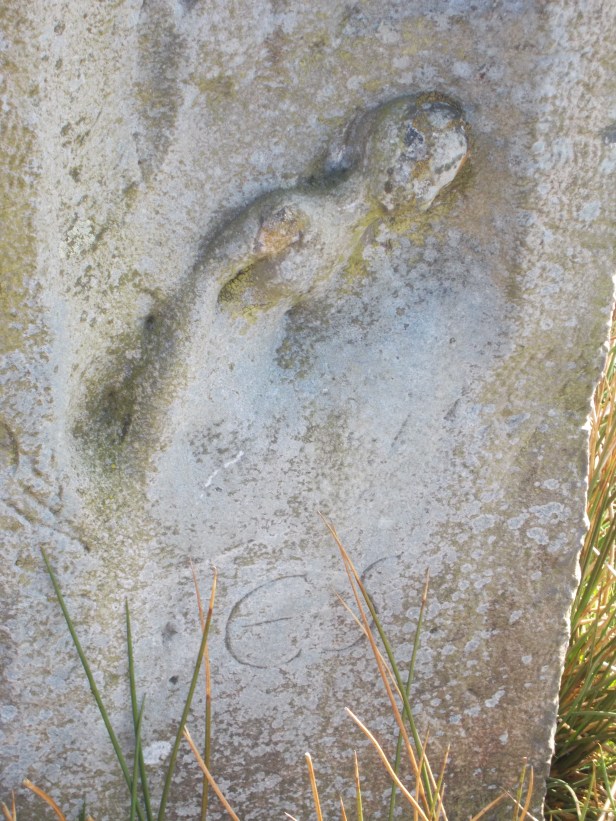
On Holcombe Moor stands a stone pillar next to a cairn. The cairn traditionally marks the place where a woman, Ellen Strange, was murdered in 1761. The circumstances of her death and the trial of her murderer were for many years the subject of local folklore, with conflicting stories being told. However, thanks to work by author John Simpson and Helmshore Local History Society, we’re now probably closer to the truth than we have been for many years. Recently the Unite union has republished the work on their website and below we’ll give a link to where you can download the booklet to read in full, for free.
We’ll start with a summary of the events that happened in the immediate aftermath to the crime and how that historical record was pieced together. Then we’ll see how the tale morphed over the years, and bring it up to date with how Ellen Strange is being remembered and commemorated in current times.
Ellen seems to have been murdered just after midnight on 26th January 1761. Two days later there was an inquest at Stake Farm, close to where her body had been found. Attending it were the coroner and attorney Simon Dearden, along with 14 local men acting as a jury, drawn from Tottington, Walmersley and Haslingden. After the inquest finished, Ellen was buried in Holcombe churchyard. The inquest decided that her husband John Broadley was guilty, he was arrested and sent for trial at the Lent assizes at Lancaster Castle.
It’s likely that the prosecution was carried out by Fletcher Norton, King’s attorney and sergeant at arms for the County Palatine of Lancaster. Witnesses called in the case against Broadley included Lawrence Elton, the Tottington constable that had indicted him; Roger Booth, a Tottington doctor who had examined Ellen’s body; Alice Ellison, an innkeeper’s wife from Haslingden and John Rothwell from nearby Holcombe Head Farm. Records don’t show what the witnesses said.
The outcome was that John Broadley was acquitted, due to lack of evidence. There is no record of anyone else being charged with the crime. The above account is from well researched work done by the Helmshore History Society in which they searched through local historic and legal documents, and virtually none of this was known before their efforts.
The discrepancy between the name Broadley and Strange could be accounted for the fact that Ellen was known by her childhood surname to locals in the area. Official records for poor people are sketchy and partial at best from this era. There is a 1728 baptismal record for Ellen Strange. She became Ellen Broadley on marrying John, who was from Clayton le Moors. It’s thought that the two may have been itinerant workers. There was a widow named Strange from Ash Farm in Hawkshaw buried in 1781, and this is thought to be Ellen’s mother.
The speculation is that Ellen was heading to her parents’ farm at Hawkshaw after a quarrel with her husband (perhaps at an inn in Haslingden – hence the innkeepers wife at the trial). Her husband caught up with her and killed her on Holcombe Moor. A stake may have been put into position to mark the place of her death, and this was later replaced with stones to make a cairn.

The folklore that has arisen about the story tells a very different tale. On the Ordnance Survey map of 1844-7 there is a cairn marked ‘Ellen Strange’. The first written reference to the incident is a ballad from 1872 published by John Fawcett Skelton. It tells the story of how Ellen fell in love with a pedlar (referred to as a ‘packman’ and a ‘Scot’ in the poem – a muddled meaning of ‘Scotchman’, a term often given to pedlars.) In this version it was he who killed her.
Just three years later the Bacup Times published a story saying it was her lover that murdered her. He was caught at Haslingden, tried and found guilty at Lancaster and hung. This grim tale has his body put in a gibbet on Holcombe Moor.
Three years after that Henry Stephenson, headteacher of Haslingden Church school, writes an account in his diary that had been told to him. In this version she had met her lover at Haslingden fair and later disappeared. Her parents had questioned him and then hired a blood hound which was brought across the moors to search for her. Her body was found beneath a pile of stones near Robin Hood’s Well. Her murderer confessed and was hung and put in a gibbet on nearby Bull Hill.
Variations of these stories continued to be told over the years right up until the time when Helmshore History Society decided to begin their research in the late 1970s (and in fact the folklore versions continue on the internet today). What are we to make of them? Outsiders being blamed in the form of a pedlar, justice seeming to be done, and retribution fairly swift and brutal?

Now let’s bring the story up to present times, with events from 1978 and 2015. On Midsummer’s Eve, June 24th 1978, there was a dusk performance of The Ballad of Ellen Strange based on John Fawcett Skelton’s Victorian ballad. The cairn had poles placed around it with pieces of white cloth on, each one painted with a different word, taken from the poetry and folklore that has grown up around the event: ‘Snow’, ‘Blood’, ‘Tears’, ‘Grave’, ‘Devil’. There were two giant figures depicting Ellen and her murderer. The interest and controversy stirred up by this drama lead the Helmshore History Society to begin their 10 year long investigation. Recently Bob Frith, the driving force behind the performance with his Bamboo + Horse theatre group has published his account of how the whole event came about. The page on his website makes fascinating reading and contains photographs from the time. See here.
Bob Frith had a stone pillar erected next to the cairn. It has a slight, falling figure on it to depict Ellen. This was carved by Don McKinley with funding from Mid-Pennine Arts. It has now become subject of folklore itself, with people saying it is ancient way marker depicting Mary and the baby Jesus. So the myths continue…
In 2015 the Unite union helped raise money for the booklet written by John Simpson and Helmshore Heritage Society to be republished and put it online as a free resource for everyone to read. This was part of their Rebel Road project and you can read more about this project on journalist Mark Write’s page here. To download the booklet which tells the story of the investigation, the folklore, the poetry and the history in great depth as well as providing maps and photographs of the area, see here. We’ve used the booklet extensively in writing this page. Do have a read of the original because there is so much more in it than we can relate in this account.
In November 2015, on a very blustery day, forty people gathered by the Ellen Strange memorial and cairn. They were members of the Unite union, campaigners against domestic violence, victims of abuse and members of the church, there to commemorate what had happened on that night so long ago. They were keen to highlight the fact that such crimes that were so common in the past, are all too common still. You can watch the short 15 minute video of it on YouTube here.
There is also an annual Ellen Strange Memorial Walk that raises money for the Endeavour Project that works to end domestic abuse. See their website here.
There is a tradition of adding a stone to the cairn as you go past, so that the story and a physical remembrance continues down the years.
Site visited by A. and R. Bowden 2018. This page updated 2023.
Access
The site is open access on a public footpath on Holcombe Moor. Grid Reference 778 195. For directions of how to get to the site, see our page on nearby Robin Hood’s Well, or click here
Nearby just a short walk away
A longer walk away
Peel Monument or Holcombe Tower
References
Ellen Strange: A Moorland Murder Mystery Explained (undated pdf), John Simpson, Helmshore Local History Society- available online at journalist Mark Write’s website here
Bob Frith’s account of the performance of The Ballad of Ellen Strange can be viewed on his website below
bobfrith.co.uk/ellen-strange-1978/
Comments are closed.